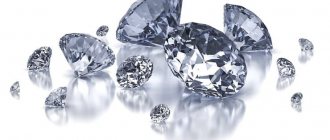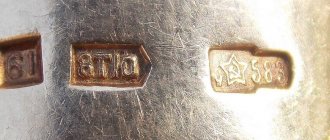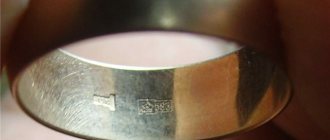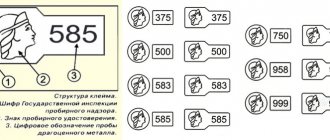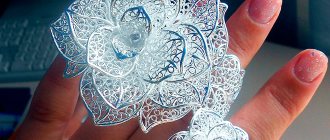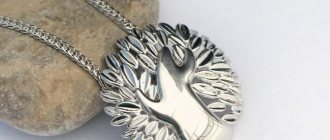Everyone wants to figure out whether a piece of jewelry is gold or gilded, or does not even have a hint of gold. After all, the desire to own this metal is strong in us. And no one wants to be deceived. Before you understand how to distinguish gold from gilding and different types of fakes, it is worth thinking about what you want to achieve by buying this or that gold jewelry.
It is possible that your goal is only to have a gold-appearing appearance. After all, the love for gold jewelry is ancient. We can say that it has been cultivated in us since childhood through fairy tales, feature films and documentaries. As we grow up, we ourselves begin to distinguish the social status of our interlocutor by the number and type of jewelry. And this is how we were brought up: the more gold we see, the higher we evaluate the position of our opponent.
Already in adulthood, we ourselves educate each other, encouraging us to compete in status things, including gold jewelry. And the desire to appear to have a higher status is understandable. This is what often pushes people to buy fakes at a bargain price.
Do you want to buy a gold ring or other jewelry, not only to emphasize your importance in appearance to your friends and colleagues, but also to gain self-confidence? Then, of course, it is necessary to understand the types of hallmarks on gold, and the options to distinguish where the gold is and where the gilding is. And the fact is that the jewelry is definitely not made of copper or other alloys.
What is gold plating in jewelry?
There are a number of conditions under which the coating is considered gold plating, and these requirements vary from country to country. So, in Russia, the layer must be at least 0.5 microns thick if we are talking about pure gold. This means that in practice the layer thickness depends on the sample:
- for 375 – no less than 2.3 microns;
- for 585 – no less than 1.2 microns;
- for 750 – no less than 0.835 microns;
- for 999 – no less than 0.5 microns.
The thicker the layer of gold plating, the more durable it will be. The thinnest coating can withstand approximately six months of active use, after which the base metal from which the product is made begins to show through the gold. Therefore, well-known jewelry brands do not produce jewelry with gold plating thinner than 0.1 mm.
Gold plating methods at home
With certain skills, compliance with safety precautions and the presence of a well-ventilated room, gilding can be done independently at home.
Preparation and use of gold chloride
Procedure:
- Prepare aqua regia.
- Dissolve any gold item in it.
- Carefully evaporate to a dry residue.
Attention: the process must be carried out very carefully, since acid fumes can cause serious harm to the respiratory tract, and there is also a high risk of chemical burns to the skin.
- Mix the resulting gold chloride with chalk and a solution of potassium cyanide to a mushy state.
- Using a brush, cover the product.
- After the surface has dried, it must be thoroughly washed and polished.
Application of zinc contact
If a thicker layer is needed, then zinc is used. It is also necessary to prepare gold chloride for it.
Procedure:
- Clean the item thoroughly and degrease it.
- Prepare the composition by mixing gold chloride with carbonic potassium, yellow blood and table salt in water.
- Heat.
- Place the item to be gilded in a container with a warm mixture.
- When the products are already in the solution, place a zinc stick in the container.
- Rinse, dry and polish.
If necessary, the product is covered with a protective layer.
Galvanic method
The galvanizing method is similar to galvanizing, but produces a more durable coating. By changing the composition of the solution, you will get different shades of gold. You will need a current rectifier and any glass container that can withstand high temperatures.
Procedure:
- Clean, degrease the product, sand it using paste and sandpaper.
- If the product is made of steel, zinc or tin, first coat it with copper.
- Prepare electrolytes from water, sodium phosphorus, gold chloride, potassium cyanide and sodium disulfide.
- Heat the resulting solution to 60 °C.
- Install the anode.
Electroplating takes from 12 to 16 hours. At the end of the process, the product is dried on sawdust and polished.
If gilding of a small surface is required, it is easier to purchase a special galvanic pencil.
Gilding on the Gulfarba
Gilding “on Gulfarba” allows you to get a matte finish. Gulfarba is a mixture of varnish, drying oil, and pinene. The surface is treated with Gulfarba, and the next day a layer of gold leaf is applied to it. Thanks to the solvent in the composition, the surface becomes matte.
How is gilding different from gold?
This question is usually asked by people who are not knowledgeable about jewelry. In fact, gilding is gold, but only applied in a thin layer to another metal. To make the base, you can take silver (most often used by jewelers), steel, copper, tin, aluminum, etc. In principle, gilding can even be applied to stone, plastic or wood, but the manufacturer must indicate this in the document attached to the jewelry.
There are several ways to apply gold plating:
- fire (mercury), widely used in ancient times and extremely dangerous to health;
- mechanical, when a thin sheet of gold leaf is attached to the surface of the product by beating;
- oil (mordan), based on gluing gold leaf onto an oil adhesive base;
- polyment (clay), previously widely used in the manufacture of icons, as well as baguettes and other interior decorations made of wood;
- water-based, used today to cover interior stucco elements.
Modern jewelers most often use galvanic gilding, when a layer of gold is applied to the surface of a product by electrolysis, involving immersing the item in a galvanic bath and passing an electric current through the solution. As a result of an electrochemical reaction, gold is deposited on the jewelry in an even layer.
If a thick layer of gold is required, the fusing method can be used, which involves treating the product with a molten precious metal. This method is used to make expensive and high-quality gold-plated jewelry.
Imitation gold
A variety of alloys are used for fake gold jewelry.
Aluminum bronze, which resembles gold in color. This alloy consists of 90% copper and 10% aluminum.
Aluminum bronze coin.
Belgica is an alloy similar to platinum. It contains about 74% iron, approximately 16% chromium, and almost 9% nickel.
Mosaic gold, which includes almost 70% copper and 30% zinc. Gives a hint of native gold.
Product made from tombak.
Tompak - this alloy is very similar to real gold. It is often brought by tourists from Turkey, Israel or China. If you don’t know how to distinguish gold, it’s better not to buy it in these countries.
There are a huge number of such alloys. Thanks to such materials, they learned to imitate real gold. Most often it is transported through smuggling. Counterfeiting gold is a very common phenomenon. Try not to fall into the “trap”.
How to distinguish gilding from real gold?
- Examine the product, find a sample and study it carefully. On silver jewelry with gilding, the silver standard is indicated - 925. Jewelry gold is available in three versions - 585 (the most common standard), 375 (the cheapest and low-quality jewelry) and 750 (expensive items not intended for everyday wear).
- Heat the decoration over the fire. If stains appear on the surface, it means you have a gold-plated or fake item in your hands.
- Apply vinegar, lemon juice or other acid to the surface of the product. Darkening is a sign of gilding.
- Take a needle and use the point to make a small scratch on the underside. Under the gilding, metal of a different color will be revealed.
Where is gold plating used?
Applying a thin layer of gold to the surface is a widespread technique that is used:
- in the jewelry industry for the production of inexpensive, but high-quality and presentable jewelry, dishes and cutlery, and other products;
- in the electronic and electrical industry in the production of parts and components with high performance;
- in architectural design for the manufacture of gilded stucco or wooden decor, baguettes, church domes, etc.;
- in the manufacture of furniture with gilded decorative parts.
Application methods
There are many known methods of gilding. The choice is determined primarily by the nature of the surface and the professionalism of the craftsman.
Fire or mercury
One of the very first methods that was used for gilding temple domes. Its essence is that a special mixture based on mercury was prepared, which was subsequently evaporated. Due to the danger to the health and life of the master, this technique is a thing of the past.
Oil based
Another name for the method is Mordan gilding, from the name of a special glue. The method is suitable for both interior and exterior work. Mordan can be purchased in specialized online stores.
Clay based
Clay-based gilding (polyment) is used only for wood and is not suitable for exterior decoration. In the old days, this was one of the most difficult and time-consuming methods, since the preparation of polyment required rare and very expensive ingredients at that time, including whale oil. The mixture was diluted using egg white. Now you can find ready-made mixtures on sale.
Water-synthetic
For this method of gilding, mixtures based on water are used. The advantage is that you can quickly prepare the surface. The gold-plated product is glossy and does not require final polishing.
Garlic
One of the oldest methods. Fresh garlic juice was squeezed onto the surface. After it dried, the surface was polished, moistened and gold leaf was applied. According to experts, this method gives the gilding a special shine.
What can I do to prevent the gold plating from peeling off?
Jewelry made from silver or base metals with gilding, as a rule, is indistinguishable in appearance from jewelry made from solid gold. But the attractive appearance is maintained only until the thin layer of gilding is erased, revealing a less valuable base.
Therefore, jewelers recommend not using gold-plated items for everyday wear. Be sure to remove them before showering, exercising, or doing housework. Such products must be cleaned very carefully so as not to damage the top layer of gold.
Methods for calculating counterfeit gold
Considering in a store what type of jewelry you want is the easiest way to distinguish gold from a fake. But if you bought jewelry from a store you've never heard of, or it was just given to you as a gift, then you need to know how else you can spot a fake.
Some proven ways to identify gold at home. They do not give a 100% guarantee, but in some cases they will eliminate doubts.
- Bite the decoration. All common grades assigned to gold indicate the content of the yellow metal itself. And there is not a single common test that would make jewelry as hard as diamond. The inherent softness of gold still remains. Therefore, you can easily distinguish the marks of your teeth if the jewelry is truly gold.
The exception is a fake with the addition of lead. There will also be a mark on it.
- Attach a magnet. Gold is a non-magnetic material, as is the ligature used in making jewelry. Accordingly, it is useless to apply a magnet to gold - it will not stick.
Counterfeits often use copper, lead and other metals used in the alloy. They are also not magnetic.
- Dip in vinegar or alcohol. Nothing will happen to gold, but metal similar to it will darken.
There is no catch in this method. No other cheap metal can withstand household acid or rubbing alcohol.
- Scratch. Should only be used as a last resort. After all, no matter what the jewelry turns out to be, you will still want to continue wearing it. Therefore, it is worth scraping where it will not be noticeable.
There is no way to hide metal under gold. If another metal is visible in the place of the scratch, then you definitely have at least a gilded piece of jewelry, and at most, the top layer is not even gilded.
- Heating. A little dangerous way. It is worth arming yourself with a special tool so as not to get burned. If after this procedure there are no stains on the gold, it is genuine.
The catch may be in the sample. Nobody canceled the deception with a fake brand. After all, 750 is more expensive.
Methods by which one could check a fake if the product is plated with gold are not relevant. Few people will counterfeit it because of the cost of the product. Passing off the same copper as gold-plated jewelry is simply not profitable and happens very rarely.
With gilding, jewelry can act as a counterfeit product in gold. Then all the methods described above will work.

